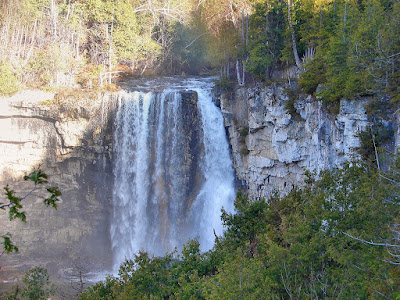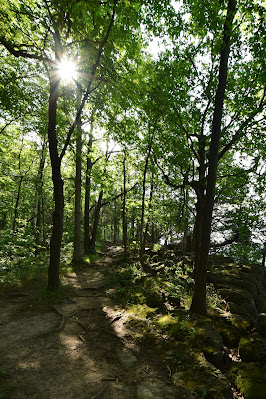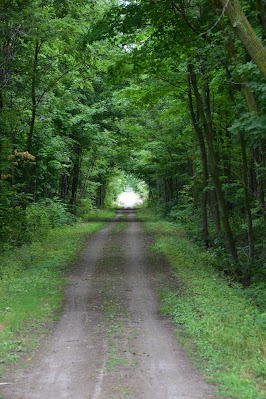Looping Back in Beaver Valley
Walking in Circles on the Bruce Trail
Refreshed
from a snug night in a comfortable bed we awoke early this morning and enjoyed
a magnificent and filling breakfast at the inn. The logistical realities of the
remainder of the Beaver Valley Section mean
that we now face a decision. We have
just over 60 kilometres to cover to both the end of this section and the only
authorized BTC campsite in Rocklyn Creek Management Area. Practically, this means that we would likely
have to wild camp twice more in Beaver Valley, a practice that is strongly
discouraged by the Bruce Trail. As such, to limit the number of occasions we
need to wild camp, we have decided on another course of action. Today we chose to do a short trek which saw
us push some 16-18 kilometres forward on the main trail from Eugenia to Hogg’s
Falls and back to the crossroads of Vandeleur, before then following the
Campbell’s / Graham’s Hill Side Trail across the valley on a 6-7 kilometre loop
back to the town of Eugenia.
The
benefit of this strategy is that it gave us extra time on this wonderful
Saturday to enjoy both Eugenia Falls and Hogg’s Falls. In addition, we were able to lodge again here
in Eugenia, which also allowed us to ‘slack-pack’, or trek without our heavy
gear, on today’s section of the Bruce Trail.
The cost of taking this short day and looping back was having to descend
and climb through the center of Beaver Valley both today and tomorrow
morning.
In
addition to our hosts treating us to a wonderful breakfast, they also made us a
couple of cheese and vegetable sandwiches for lunch later in the day! Such wonderful trail magic!
History of Eugenia Ontario
With our day packs readied and our heavy camping gear left in our room, we set off back to the Bruce Trail, navigating through town to the Eugenia
Soldiers War Memorial and today’s starting point. The town of Eugenia purportedly was surveyed
and settled in the 1850s, with both the village and nearby natural wonders
being named after Princess Eugenie, the wife of Napoleon III. Throughout the mid-nineteenth century, this
area underwent a quick period of growth after prospectors arrived chasing
rumours of gold. Dozens of claims were
struck throughout this area as a result of this movement, but unfortunately,y
nothing was ever discovered beyond a large deposit of iron pyrite, or fool’s
gold.
Regardless, the region continued
to develop, and by 1870 a number of mills had opened and were operating along
the Beaver River. The community of
Eugenia soon included trade shops (blacksmiths and carpenters), stores,
churches, and a school. Unfortunately,
this expansion was soon halted when regional railway development bypassed the
Beaver Valley. Fortunately, this led to
the transformation of this locality into a quiet town which is at present a
popular tourist destination owing to the natural beauty of Lake Eugenia and
Eugenia Falls, as well as the proximity of local ski resorts throughout Beaver
Valley and the Bruce Trail.
Eugenia Falls and the
Cuckoo Valley
Entering the Conservation Area from the town we were soon at Eugenia
Falls, a 30 m waterfall, which is the tallest in the region. Set amid a
stunningly beautiful forested natural area, this waterfall, which is fed by the
Beaver River, drained into a basin below in the Cuckoo Valley. According to oral histories and early
accounts by European settlers, this region is so named because of the
proliferation of cuckoo birds and their nests here. Seeing or even hearing a Yellow-billed or
Black-billed Cuckoo would have made an exciting addition to our trek today, but
sadly we didn’t have any such luck.
Walking on, the trail took us steeply downhill past a number of stone
arches. According to the BTC Guidebook,
these are the remains of an attempt to divert local water from the waterfall in
order to generate power. Unfortunately,
the plan resulted in the bankruptcy of the Georgian Bay Power Company. However, these arches of the original water
diversion system still exist, as we saw while walking,
We crossed the river on a Conservation Area bridge and soon found
ourselves weaving downhill on the hard-packed dirt trail through a cedar
forest. This led us to a wonderful
lookout over the Beaver Valley before connecting to Lower Valley Rd. There we were surrounded by a lively
marshland that was filled with songbirds, including Marsh Wrens, a pair of
Common Yellowthroats, and a multitude of Red-winged Blackbirds.
Following
the roadway for a short distance, we discovered a sign noting that we were due
to pass through a maple farm. Turning
off the road, we began to slowly climb back up the escarpment through a sugar
maple stand, which – as evidenced by the taps in the trees – was the property
of the Beaver Valley Maple Farm. We soon reached the summit, a
climb made easier by not having backpacks on, and crossed an open grassland
meadow. Unfortunately, (especially on
the Bruce Trail) what goes up must come back down – and vice versa – and often
repeatedly, and in quick succession. As
such, the next couple of kilometres saw us first ascend and then descend,
before once again climbing out of the marshy creek valley to an open field,
before heading downhill along an abandoned logging road into another
valley.
Hogg’s Falls
After about 7 km of hiking, and a ton of effort, we began our approach
to Hogg’s Falls. There we navigated
through a dense but open confer forest along a wide and well-used public
trail. Traversing this area the Bruce
Trail crossed an open clearing, wove along the landscape, and eventually led us
to cross Lower Valley Rd before bringing us to Hogg’s Falls. Unlike Eugenia Falls, which was exceedingly
tall, Hogg’s Falls was a short but wide cascade. Situated in a secluded hollow, it was a
beautiful location. Hogg’s Falls was
named for William Hogg, a member of the powerful Hogg Family who resided in
Victorian Toronto. In the 1870s, William
Hogg settled in this area and established a mill.

Unfortunately, while Hogg’s Falls was undoubtedly a wonderful place that
we could easily imagine relaxing beside, our experience there was one of large
crowds of people who had little patience for others. People shuffling along the
trail in flip-flops, individuals texting and drinking in the middle of the
trail, and a lot of discarded garbage from the weekend’s visitors did little to
make us want to spend more time there.
In addition, no matter where on the trail we ventured, we seemed to be
in someone’s way. Particularly onerous
was the fact that every time we stopped to take a picture, someone would spot
the camera and rush over to either push us out of the way or step in front of us
to take the same image. This happened
repeatedly, and no comment was ever made by anyone, and no apologies were
offered. As such, though this seemed like a wonderful spot to visit, it was
clear that a beautiful spring weekend was not the best time to hike the
Bruce Trail at Hogg’s Falls. As such, we
decided that it was best to just continue on.
The Bruce Trail continued on, following the path of the local waterway,
taking us past the overwhelming busy parking lot, and leading us to take a
brief sojourn onto a local roadway to cross over the Boyne River. En route, we discovered a small
white sign mounted on a tree highlighting that we had reached the southernmost
point of the Beaver Valley section. This
sign also noted that we were now only 388.9 km south of Tobermory and that we
had covered some 508.6 km since setting out from Queenston! Reaching the southern terminus of the Beaver Valley
section, the path turned and began what will be a 42 km trajectory
northward.
Northbound: Hogg’s Falls to Vandeleur
After
trekking south along the eastern ridge of Beaver Valley over the past couple of
weeks, we have now started north again along the western ridge of the valley.
We continue to be in awe of the rugged beauty in this area as we
navigated the western edge of the escarpment, circling the Beaver Valley. Over the next few kilometres, we continued the
process of descending and then re-ascending the side of the escarpment amid a
lush forest – a process that was made much easier without the weight of our
backpacks.
Traversing
Johnson’s road, the Bruce Trail continued on – crossing agricultural fields
and farmland, passing through a forest, and tracing alongside a wooden
fence. Once again, BTC volunteers have
constructed wooden bridges across streams and potentially muddy spots throughout this area – for which we are very grateful.
The amount of infrastructure and amazing signage that we have benefitted
from since leaving Queenston Heights is truly stunning to reflect on. The effort, energy, and dedication of
volunteers to install and regularly maintain the Bruce Trial is wondrous.
Lunch at Day’s End
Sadly, the trail too quickly emerged at the 12th concession,
marking the end of our northern trek today.
Climbing the wooden stile over the rough wood and wire fence, we were
back on the gravel roadway.
Depressingly, it was only 12 noon when we reached this point on the
trail, suggesting that we could possibly have pushed much further and found a
place to wild camp on the trail.
Admittedly, a lot of BTC hikers and online resources have suggested that
the forests in front of us, only 10 or 15 kilometres ahead, are both viable and
often used places to set up for the night.
Uncertain of this, we did not gamble this morning. There are days that the terrain on the Bruce
Trail can be exhausting even over short distances, and there are places where
others would be willing to wild camp that we would not. In the end, you don’t know until you have
been there and seen for yourself.
Regardless, without our gear on us, there was little point in
considering the “what ifs” of past decisions.
Instead, we walked a few hundred feet west on the gravel roadway to the
BTC parking area, where we sat off the road and enjoyed the lunches which our
hosts had made for us this morning.
Half an hour later we set out from the parking area near the
intersection of Vandeleur.
Heading east, we could again see the two towers of Eugenia’s hydroelectric plant across from us on the eastern ridge of Beaver Valley, which we
had passed yesterday on the BTC heading south. Seeing them from this
perspective meant that we had walked “around the compass” in the last 20 or so
kilometres – amid our hike westward we had ventured south to Eugenia and Hogg’s
Falls, before turning north to our present position. The final part of our day, looping back to
Eugenia, would complete the circle taking us back east.
Looping Back: The Eastward Journey
This
morning, given the nature of the region and the challenges of camping along the
Bruce Trail, we had made a hard choice.
With no viable camping place in the 60 kilometres between Eugenia and
Rockyln Creek, we had decided to take a short day on the trail with the hopes
that it would allow us to move forward along the Bruce without the need to wild
camp. Hence, having completed only 16-18
kilometres since setting out four and half hours ago, we turned east and took
the Campbell’s / Graham’s Hill Side Trail.
This pathway essentially crossed Beaver Valley on a quiet, narrow,
gravel country lane that led us down a steep descent before re-climbing the
eastern side of the escarpment.
Once back
to the main trail – a portion that we had already hiked at the end of yesterday
– we re-trekked the 4 kilometres from Campbell’s Hill back into the town of
Eugenia. An hour and a half after leaving the main
trail, trekking north from the side trail and heading back east, we again walked
into Eugenia Falls Conservation Area.
With far more bounce in our steps, than we had yesterday, we arrived at
the Eugenia Soldiers War Memorial and Bruce Trail parking lot before weaving
into the town of Eugenia. Wildly
impressed with our meals yesterday, we walked directly back to the Flying Chestnut Kitchen to enjoy a few
cold beers and a bowl of vegetable pasta to celebrate our 25th Bruce
Trail trek!
By late afternoon we made our way back to our accommodations, where we
laundered our clothes for the second day in a row, cleaned up, showered, and
planned for the push onward tomorrow.
.jpg)


.JPG)





.JPG)


.jpg)
Comments
Post a Comment